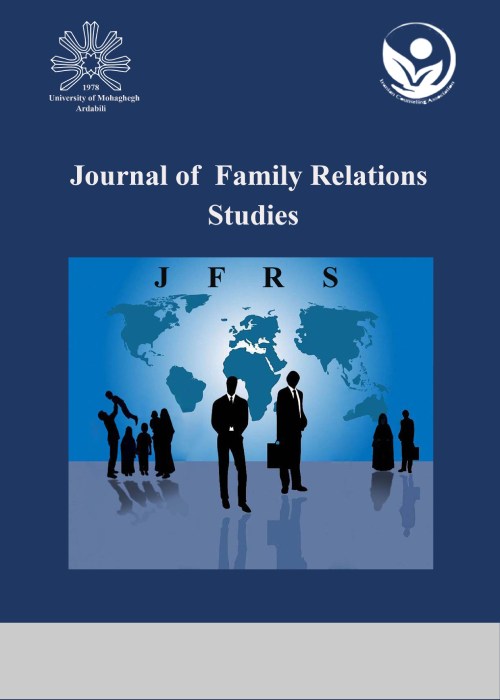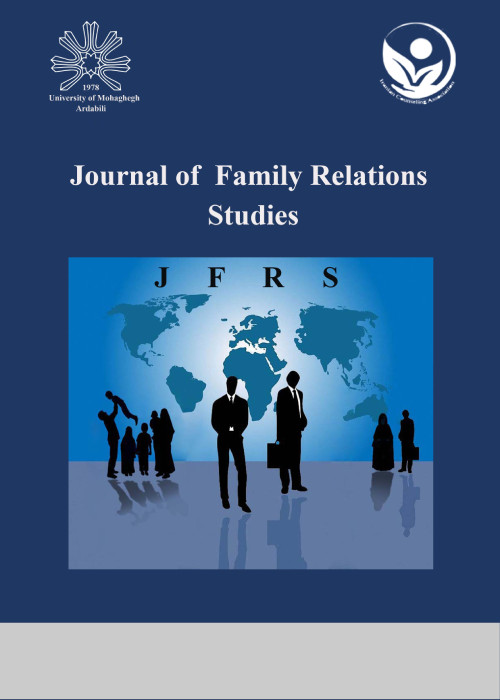فهرست مطالب

Journal of Family Relations Studies
Volume:3 Issue: 9, Apr 2023
- تاریخ انتشار: 1402/04/03
- تعداد عناوین: 6
-
-
Pages 4-10ObjectiveThis research was conducted with the aim of causal modeling of resilience based on basic psychological needs with the mediation of attachment styles in students from single-parent families.MethodsThe current research was carried out through the descriptive-correlation method (path analysis). The statistical population included all students studying in Mohaghegh Ardabili University in the first half of the 2018-2019 academic year. Among them, 170 people were selected using the available sampling method and answered the Basic Psychological Needs questionnaire of Ryan et al. (2000), Hazen et al.'s Attachment Styles (1987), and Connor et al.'s Resilience (2003). The obtained data were analyzed using structural equation modeling by smart pls3 software.ResultsThe results showed that basic psychological needs had a direct and significant effect on resilience, and the indirect effect of basic psychological needs through the mediation of attachment styles was confirmed. The results of regression analysis showed that the predictive variables predicted about 30 % of the resilience variation.ConclusionIt is suggested that experts in the field of mental health use the findings of the present study in the framework of their educational and intervention programs, especially in working with children of single-parent families.Keywords: Basic psychological needs, Attachment styles, Resilience, single-parent families
-
Pages 11-20ObjectiveOne of the most common childhood disorders is attention deficit-hyperactivity disorder (ADHD). The objective of the present study was to compare the effectiveness of child-parent relationship trianing and Barkley’s parent training in behavioral-emotional problems of children with ADHD.MethodsThe research method was quasi-experimental with pretest-posttest and follow-up. The statistical population of the study included all mothers with a son with ADHD. These mothers’ children were studying in one of the primary schools in Ahvaz in the academic year 2021-2022. They were selected through random clusters sampling method and randomly were assigned to child- parent relationship therapy (n = 15), Barkley's parent training (n = 15) and control (n = 15) groups. Moreover, Clinical interview, Children’s Behavior Checklist and SNAP-IV training Scale were instruments of collecting data. Achenbach Behavior Scale was used to collect data. The child-parent relationship group participated in ten 60-minute sessions; the Barkley’s parent training group participated in fifteen 60-minute sessions. However, the control group did not receive any intervention. Data were analyzed using mixed analysis of variance using SPSS software (version 25).ResultsThe results of intragroup effects showed that child-parent relationship therapy and Barkley’s parent training were effective in the behavioral-emotional problems in the posttest phase (P < 0.05); they reduced children's emotional-behavioral problems. However, the effects were not sustained (P < 0.05). In addition, there was no significant difference between the effectiveness of child-parent relationship therapy and Barkley’s parent training in children's emotional-behavioral problems (P < 0.05).ConclusionAccording to the results of the study, child-parent relationship therapy and Barkley’s parent training were effective in emotional-behavioral problems of children with ADHD. Therefore, clinical psychologists and counselors are recommended to use these methods to reduce emotional-behavioral problems of children with ADHD.Keywords: Child-parent relationship therapy, Barkley’s parent training, Emotional-behavioral problems, Children with attention deficit-hyperactivity disorder
-
Pages 21-32ObjectiveThis research aimed to study mothers' lived experiences during the COVID-19 pandemic.MethodsThe research methodology was qualitative, and the research type was phenomenological. The statistical population of the study consisted of mothers with student children who had high levels of depression, anxiety, and stress based on the DASS-24 questionnaire due to the experience of the coronavirus pandemic in 2021 The sampling method was purposeful and continued until theoretical saturation was reached (30 people). Collaizi's seven-step analysis method was applied to analyze the interviews. The gathering and analysis of the data were handled simultaneously.Results1177 codes were extracted and eventually categorized into 6 components. The findings indicate that we can study mothers' lived experiences during the spread of COVID-19 from six perspectives: constructive lived experiences during the COVID-19 pandemic, emergence, and development of psychological issues, social issues, educational and cultural issues, family issues, and physical and systemic issues.ConclusionThe findings of the current research showed that the widespread of the COVID-19 disease had created problems in the different fields of life from the mothers' point of view, But the spread of this disease has provided them with positive experiences such as self-improvement and personal growth.Keywords: Lived experiences, COVID-19, Physical consequences, Psychological consequences, Social consequences
-
Pages 33-45Objective
Covid-19 outbreak changed human being interactions in all of the world, and family as smallest social unit of society had experiences in new situation. Accordingly, the present study aimed to explore the How the Covid-19 pandemic changed the quality of Iranian families’ interaction?
MethodsThis study examined the quality of family interactions during the COVID-19 epidemic using a qualitative grounded theory approach. The research population was families living in Tehran. The participants were 25 persons including 7 couples and 11 young adults who were selected using purposive sampling in 2021 in Tehran. The data were collected through semi-structured interviews with the participants. The collected data were analyzed based on Strauss and Corbin’s approach.
ResultsThe results revealed that COVID-19 affected 5 Axial coding including; “Family interaction challenges”, “Changes in the quality of family interactions”, “Concerns about the occurrence of physical and mental problems for family members”, “the impact of changing working hours” and “economic problems on family interactions”, and the consequences of reconstructing family interactions leading to weak family ties. The COVID-19 pandemic also had consequences such as economic problems, exacerbation of external stresses such as unemployment, disregard for family relationships, and exacerbation of work-family conflict.
ConclusionThis study also showed that families rebuild family interactions by turning challenges into opportunities, redefining communication boundaries, rebuilding family interactions, and redefining family roles and functions.
Keywords: Family Interactions, Relationship Quality, couples, Pandemic, COVID-19, Grounded Theory -
Pages 46-52ObjectiveThe aim of this study was to investigate the role of object relations in predicting emotional expression, distress tolerance and marital quality.MethodsThe research method was quantitative, applied and descriptive-correlational. The statistical population of the study was all 257 couples which formally married in the first three months of 2022 in Ardabil. The non-random available sampling method was used due to the limitations of the corona pandemic. The sample size was 110 couples, including 110 males and 110 females. Bell Object Relationships Inventory (1995), King & Ammons Emotional Expression Questionnaire (1990), Distress Tolerance Scale (DTS) and Basby Marital Quality Questionnaire (1995) were used for data collection. In the descriptive part, we used the central and dispersion indices. Also, in the inferential part, multiple regression was used. The data were analyzed using SPSS software.ResultsThe results of this study showed there is a significant negative relationship between social incompetence with emotional expression, distress tolerance and marital quality (p<0.01), and a significant negative relationship between egocentricity with emotional expression, distress tolerance and marital quality (p<0.01). Also, there is a significant negative relationship between insecure attachment with emotional expression, distress tolerance and marital quality (p<0.01) and finally there is a significant negative relationship between alienation with emotional expression, distress tolerance and marital quality (p<0.01).ConclusionConsidering the results, couple therapy based on object relations can be used to improve emotional expression, distress tolerance and marital quality of couples.Keywords: Object relations, Emotional Expression, distress tolerance, Marital Quality
-
Pages 53-60ObjectiveIntergenerational transmission of schemas has received more attention in recent years. Then the aim of this study was to investigate Intergenerational transmission disconnection and rejection domain of maladaptive schema in mother-daughter relationships: the mediating role of the perceived Maternal Attention.MethodsThe method of research was correlation-structural equation modeling, and the research population was all mothers and their daughters in city of Mashhad, of which 207 groups of mothers (30-69) and daughters (16-30) were selected using the convenience sampling method. The sample group filled out the questionnaires, including Young Schema Questionnaire–Short Form Version 3 (YSQ-S3) (2005) and Parental Bonding Instrument of Parker’s et al., (PBI) (1979). The data was analyzed using amose-24 and spss-24 software.ResultsThe findings showed that the Perceived Maternal Attention can mediate the relationship between disconnection and rejection domains schemas in mothers and daughters.ConclusionIt can be concluded that the schemas of disconnection and rejection can affect the formation of these schemas in the daughter by transferring the perceived Maternal Attention to the daughter.Keywords: Intergenerational transmission, early maladaptive schemas of disconnection, rejection domains, mother, daughter


